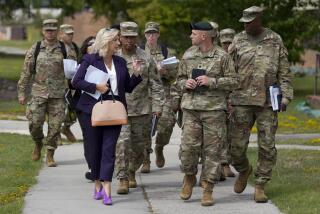Army to Activate Reserve Pool
WASHINGTON — For the first time since Operation Desert Storm, the Army plans to announce this week an involuntary mobilization of thousands of troops from the Individual Ready Reserve, the latest signal that the service is struggling to bolster ranks stretched thin by the global war on terrorism.
The move, which Army officials say is likely to involve notifying roughly 6,500 soldiers about a possible deployment, is meant to fill holes in active and reserve units preparing to go to Iraq and Afghanistan this fall and early next year.
In most cases, the Pentagon created the holes when it took soldiers with critical skills in short supply -- such as civil affairs, intelligence, vehicle maintenance and truck driving -- out of their units and shifted them to military units needed for more urgent deployments since the Sept. 11 terrorist attacks.
Now the bill for this system of “robbing Peter to pay Paul,” as one defense official put it, has come due.
“After a while, the units you’ve been borrowing from have got to be filled out,” said an Army official who had been briefed on the plans and would speak only on condition of anonymity.
The Individual Ready Reserve, or IRR, is a pool of roughly 118,000 former soldiers who are not members of a specific reserve unit, yet who have unexpired obligations to complete their military service. In some cases, they are soldiers who received honorable discharges before their commitment was scheduled to end and are legally bound to fulfill their contract if the Pentagon requires their services. Several thousand of these soldiers are already serving in Iraq, the majority of whom are volunteers.
Pentagon officials had said for weeks that tapping the IRR was in the works. The Army’s plan is being explained on Capitol Hill in advance of the announcement, expected Wednesday, defense officials said.
Even with the notification of an involuntary call-up, the Pentagon does not expect to need all the IRR soldiers it notifies. The Army official said that as few as 2,000 IRR soldiers could be assigned to units preparing to deploy abroad.
In 1990, during preparations for Operation Desert Storm, 20,000 soldiers from the IRR were called for service; this will be the first time since then that a significant number of IRR troops have been mobilized.
Even with the transfer of political authority in Iraq, the Pentagon expects to have more than 100,000 troops there for the foreseeable future, and it maintains roughly 18,000 troops in Afghanistan. In addition to its current pace of deployments, the Army is transforming its combat divisions into smaller, autonomous brigades that can be sent more easily to war zones.
Defense experts said the decision to tap the IRR was an effort to protect stateside units undergoing this transformation from being raided by a Pentagon looking to fill out units being dispatched abroad.
“The particular concern is that we not under-man either the units we are transforming or the units going to Iraq,” said Daniel Goure, a vice president at the Lexington Institute, a defense policy and research center in Arlington, Va.
In recent weeks, Army officials have announced a series of personnel moves as they try to meet global commitments with a force about one-third the size of the Army during the Cold War. Earlier this month, Lt. Gen. Franklin L. Hagenbeck, the Army’s personnel chief, announced that soldiers who had planned to leave the military would be ordered to stay if their units were deploying to Afghanistan or Iraq.
Since the war on terrorism began, the Pentagon has issued thousands of such “stop-loss orders,” yet Defense Secretary Donald H. Rumsfeld and Army Chief of Staff Gen. Peter J. Schoomaker repeatedly have said that the Pentagon does not need to ask Congress to increase the size of the military.
More to Read
Sign up for Essential California
The most important California stories and recommendations in your inbox every morning.
You may occasionally receive promotional content from the Los Angeles Times.










